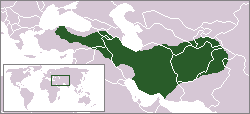Medes: Ancient Iranian People
The Medes were an ancient Iranian people and one of the ancestors of modern Kurdish people who lived in the northwestern portions of present-day Iran.
This area was known in Greek as Media or Medea They entered this region with the first wave of Iranian tribes, in the late second millennium BC (at the end of the Bronze Age).
Median Empire | |||||||||
|---|---|---|---|---|---|---|---|---|---|
| c. 625 BCE–549 BCE | |||||||||
 Median Empire, ca. 600 BC | |||||||||
| Capital | Ecbatana | ||||||||
| Religion | Zoroastrianism possibly also Proto-Iranian religions such as Yazidism | ||||||||
| Government | Monarchy | ||||||||
| King | |||||||||
| Historical era | Iron Age | ||||||||
• Cyaxares united Median tribes | c. 625 BCE | ||||||||
| 549 BCE | |||||||||
| |||||||||
By the 6th century BC, the Medes were able to make their own empire. It stretched from southern shore of the Black Sea and Aran province (in modern Azerbaijan) to north and central Asia, Afghanistan, and Pakistan.
The Medes are credited with the foundation of the first Iranian empire, the largest of its day until Cyrus the Great established a unified Iranian empire of the Medes and Persians, often referred to as the Achaemenid Empire.
Controversy


Modern scholars question whether a Median empire even existed. It is argued that even if it existed, it must have been just a political alliance among highland neighbors of the Assyrians.[source?] The alliance might include Armenia in southeastern Anatolia, Sagartians in modern northern Iraq, and the actual Medians in the area between what is today Hamadan-Kirmanshah in cental Zagros. Neither cuneiform sources, archaeological evidence, or biblical accounts, support Herodotus, who claimed there really was a Median empire.
Median language
Strabo mentions the affinity of Mede with other Iranian languages in his "Geography":
The name of Ariana is farther extended to a part of Persia and of Media, as also to the Bactrians and Sogdians on the north; for these speak approximately the same language, with but slight variations.
— Geography, 15.8
Herodotus, mentions the word "Spaka" ("Dog", still present in current Iranian languages such as tat and talysh, and different from Persian)
References and Notes
This article uses material from the Wikipedia Simple English article Medes, which is released under the Creative Commons Attribution-ShareAlike 3.0 license ("CC BY-SA 3.0"); additional terms may apply (view authors). Content is available under CC BY-SA 4.0 unless otherwise noted. Images, videos and audio are available under their respective licenses.
®Wikipedia is a registered trademark of the Wiki Foundation, Inc. Wiki Simple English (DUHOCTRUNGQUOC.VN) is an independent company and has no affiliation with Wiki Foundation.